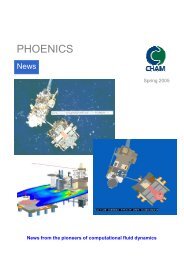PHOENICS - Arcofluid
PHOENICS - Arcofluid
PHOENICS - Arcofluid
You also want an ePaper? Increase the reach of your titles
YUMPU automatically turns print PDFs into web optimized ePapers that Google loves.
<strong>PHOENICS</strong><br />
News<br />
Redesign of SEN tube for Continuous<br />
Casting of Steel<br />
The SEN (Submerged Entry Nozzle) tube in<br />
continuous casting delivers liquid steel from a<br />
reservoir (Tundish) to the mold for final<br />
solidification into slabs. At United States Steel<br />
Corporation (“U. S. Steel”), the SEN tube has two<br />
port openings from which the steel enters the mold<br />
from the tundish. The ports have a down angle to<br />
direct the flow down inside the mold and the ports<br />
are located slightly above the bottom plane of the<br />
SEN, so that there is an internal recess or cup<br />
height. Recently, use was made of <strong>PHOENICS</strong> fluid<br />
dynamics software to mathematically model the<br />
flow of liquid steel in the mold.<br />
The work involved increasing the useful life of the<br />
SEN tube being used at a U. S. Steel plant. Since<br />
the tube life was dictated primarily by mold flux<br />
attack on the tube refractory at the liquid interface,<br />
increased thickness of the SEN refractory wall by<br />
reducing the inner bore diameter of the tube, would<br />
help to increase the life of the tube. However,<br />
when the plants initially reduced the inner bore<br />
diameter from 90 to 80mm, the flow speeded up<br />
and changed significantly near the liquid surface,<br />
such that mold flux powder on the steel surface<br />
was being entrapped into the steel, thus reducing<br />
steel cleanliness and quality. Mathematical<br />
modeling of the flow in the mold was performed to<br />
solve this problem.<br />
Using <strong>PHOENICS</strong>, the flow profile in the mold was<br />
computed for the existing SEN design, the<br />
unsuccessful reduced bore design and some new<br />
proposed designs incorporating the reduced bore<br />
technology. The velocity and turbulence values at a<br />
plane near the liquid surface were recorded for all<br />
the cases. The objective was to match the velocity<br />
and turbulence values generated by the proposed<br />
reduced bore design as close as possible to that<br />
generated by the existing big bore SEN design near<br />
the top surface of the liquid, which is the region<br />
where the mold flux powder was being entrapped.<br />
To model the free surface at the top, the IPSA<br />
algorithm was employed. The KE model was used<br />
to model the turbulence and a fixed volumetric<br />
flow rate condition was imposed at the inlet.<br />
The steel flow pattern at t=25seconds for the<br />
current big bore tube is shown in Figure 1 while<br />
Table 1 is a partial list of the different SEN designs<br />
that were investigated. Version K is the big bore<br />
tube, version A is the unsuccessful reduced bore<br />
design and version X is a new reduced bore design.<br />
Summer 2008<br />
Table 1: Description of all the different SEN tube designs<br />
investigated<br />
Tube Type Version Description<br />
Index<br />
Current J Tube K Bore 90, Port 70x90,<br />
Angle 15, CupHt 66<br />
SmallBore<br />
X Bore 80, Port 70x80,<br />
ModifiedPort<br />
Angle 20, CupHt 55<br />
Experimental L A Bore 80, Port 70x80,<br />
Tube<br />
Angle 15, CupHt 66<br />
Figure 1: Schematic of the liquid steel flow in the mold<br />
from the two-ported SEN.<br />
Velocity (m/s)<br />
0.035<br />
0.03<br />
0.025<br />
0.02<br />
0.015<br />
0.01<br />
0.005<br />
0<br />
Velocity Values Near Top Surface of Liquid<br />
0 0.1 0.2 0.3 0.4 0.5 0.6<br />
Distance from Mold End Wall (m)<br />
Current J Tube-VerK<br />
Reduced Bore Tube-VerA<br />
Reduced Bore Mod-VerX<br />
SBoreJ-VerS<br />
SBoreLModPortsFlare-VerF<br />
Figure 2: velocity values near top surface of liquid for<br />
different SEN designs.<br />
Figure 2 shows the velocity values along a line near<br />
the top surface of the liquid in the mold, extending<br />
from one end of the mold to the other along the<br />
centerline. All the different designs investigated,<br />
version X (red line) has the closest match to version K<br />
(blue line) the current big bore tube. Version A (pink<br />
line), the unsuccessful tube shows higher velocity<br />
over most of the surface compared to version K and<br />
caused the mold flux entrapment. Thus version X<br />
design was trialed in the plant and the tube life index<br />
improved from a value of 0.68 to 1.0 i.e. almost 50%<br />
improvement and this design has been currently<br />
adopted for use at the plant leading to cost savings.<br />
Dr A K Sinha,<br />
Email: ASinha@uss.com<br />
News from the pioneers of computational fluid dynamics 7








